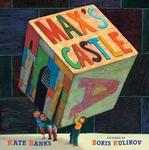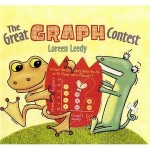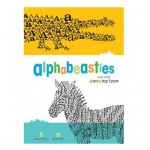Max’s Castle
 Let me make it easier for you this holiday season, because I know how it is. You want to buy a book for a child for the holidays, but you think they’d probably like a toy better, but you don’t want to give plastic junk, and yet do kids even like educational toys? Do you give the kid an abacus and watch that smile dissolve, or do you give in and buy a lead-coated choking hazard that promotes violence and unhealthy body images?
Let me make it easier for you this holiday season, because I know how it is. You want to buy a book for a child for the holidays, but you think they’d probably like a toy better, but you don’t want to give plastic junk, and yet do kids even like educational toys? Do you give the kid an abacus and watch that smile dissolve, or do you give in and buy a lead-coated choking hazard that promotes violence and unhealthy body images?
Get Max’s Castle written by Kate Banks and illustrated by Boris Kulikov along with wooden letter blocks, a game of Scrabble, or Bananagrams and everyone’s happy! If you have an iPad, tech it up for free by downloading the free Magnetic Letters app to play along while you read!
Max’s Castle is full of imagination and creative problem-solving, along with letter recognition and spelling. I love the way Banks and Kulikov show that switching a few letters changes words. Max and his brothers use alphabet blocks to build a castle. Kulikov does a fantastic job with letter arrangement: Max is in the MOAT hanging onto a block that is angled with an M and a B when Benjamin says they need a BOAT. The boys use the letter blocks to solve problems, like when the ADDER that is literally “in” the DARK DUNGEON (Banks capitalizes the words the boys have built with blocks) is causing problems, the boys take the L from the BUGLE to make the ADDER a LADDER.
Once you share Max’s Castle with that lucky kid or with your lucky students, give the kids letter blocks or Scrabble tiles or the iPad with the Magnetic Letters app to play with and rearrange! You can let students explore independently, or give challenges, like “Here comes a SNAKE ready to attack – what could you make to solve the problem?” Kids can switch out letters to make a RAKE to shoo away the snake, or TAKE it to the woods, or give it a SNACK to eat instead of eating you, etc. Encourage students to see if they can make the word look a bit like the object it represents, like Kulikov did, or use the blocks or tiles to build a structure like Max and his brothers did. Kids will build upon the Common Core State Standards of Print Concepts, Phonological Awareness, and Phonics and Word Recognition while they build fine motor skills. You’ll be the hero of the holidays!
Read MoreWhat To Do With All That Halloween Candy: Try The Great Graph Contest!
 When I was a kid, my brother and I would empty out our bags after trick-or-treating on Halloween and divide the candy into piles: lollipops, bubble gum, candy we were willing to trade, favorites that would be hoarded, etc. I kept careful count of how many of each of my favorites I had, to make sure I’d know if one went missing (my brother was sneaky.) If I’d only had access to The Great Graph Contest by Loren Leedy when I was little, I could’ve made the best kind of bar graph – a candy bar graph – and organized all my trick-or-treat information with real-life math practice.
When I was a kid, my brother and I would empty out our bags after trick-or-treating on Halloween and divide the candy into piles: lollipops, bubble gum, candy we were willing to trade, favorites that would be hoarded, etc. I kept careful count of how many of each of my favorites I had, to make sure I’d know if one went missing (my brother was sneaky.) If I’d only had access to The Great Graph Contest by Loren Leedy when I was little, I could’ve made the best kind of bar graph – a candy bar graph – and organized all my trick-or-treat information with real-life math practice.
In The Great Graph Contest by Loren Leedy, a toad and a lizard compete to see who can make the best graphs. Leedy introduces bar graphs, picture graphs, pie charts, and Venn diagrams simply and with a sense of humor. Your class can use the information on making graphs to practice math with a subject they will find inherently interesting – their candy.
So, share the book with your students (noting with pride how easily you are working the Common Core State Standard of Range of Reading into your curriculum.) Next, get your hands on some candy. You can have students bring in some from home, you can steal from your own kids’ Halloween stash, you can get an assorted bag from the store – if lots of candy in the classroom doesn’t sound like a sweet deal to you, have students just bring in wrappers.
Talk about the different kinds of graphs found in the book, and which would be best suited to organize information about your candy. Sort candies by color of wrapper, ingredients, by beginning letter, etc. Paste wrappers to make a picture graph, or create bar graphs if you have large amounts. Make Venn Diagrams for things like “candies with chocolate”, “candies with nuts” and which candies would be the union. Graphing candy makes for a sweet math activity!
For more information, visit Loren Leedy’s website at: lorenleedy.com.
Read MoreAlphabeasties and other Amazing Types
My husband, the illustrious author/illustrator Matt Faulkner, is very intelligent (note his wise choice when picking a spouse). He was also the last kid in his class to learn the alphabet. Matt is very visual, and one of the reasons he had a hard time distinguishing some letters was because they can look so different depending on the font. That’s why Alphabeasties and other Amazing Types by Sharon Werner and Sarah Forss is so terrific. This alphabet book makes animal pictures and alliterative phrases using different typefaces. Uppercase Gs are shown with and without a “beard”, and you’ll see a lowercase g sometimes has a “groovy curl on its head” but sometimes it doesn’t. A gaggle of Gs and gs group together to make a giraffe standing in long blades of grass. The sheep shapes are made of S’s, so the sheep sheared with scissors has a pile of curly S’s at its feet. It’s great to have a book point out that letters can look different in books because of the typeface – “a lowercase a can wear a little hood” or “a lowercase a can be a ball and a stick.” No wonder it earned starred reviews and Parent’s Choice awards. Alphabeasties and other Amazing Types will help all those visual “Picture Smart” learners with letter recognition and the Common Core State Standard of print concepts.
If you have access to computers and printers, let students choose interesting fonts in which to type and print their names. Bring in magazines, newspapers, coupons, etc. for students to cut up and compare letters in different fonts. Students can glue all the a’s on a big A shape, etc., or make alliterative classroom pictures with them by drawing an outline of the animal and letting students glue the corresponding letters onto the shape. An Alphabeasties Amazing Activity Book is available in bookstores along with flashcards. When you’re ready for fun with numbers, check out Werner and Forss’s book Bugs by the Numbers.
For more information about Sharon Werner and Sarah Forss, visit their website at wdw.com
Lemonade and Other Poems Squeezed from a Single Word
 I know, I know, it’s September, we should be discussing fall titles, but here in Michigan it’s a glorious sunny day, perfect for Lemonade and Other Poems Squeezed from a Single Word written by Bob Raczka and illustrated by Nancy Doniger. Using only the letters from a single word, Bob Raczka makes short, sweet poems. (In the book, Raczka and Doniger show the long word, the letters falling, and how the letters rearrange to make new words, but for the sake of brevity I’m tightening the line spaces here. Use your imagination.)
I know, I know, it’s September, we should be discussing fall titles, but here in Michigan it’s a glorious sunny day, perfect for Lemonade and Other Poems Squeezed from a Single Word written by Bob Raczka and illustrated by Nancy Doniger. Using only the letters from a single word, Bob Raczka makes short, sweet poems. (In the book, Raczka and Doniger show the long word, the letters falling, and how the letters rearrange to make new words, but for the sake of brevity I’m tightening the line spaces here. Use your imagination.)
Spaghetti: papa has a pasta appetite he eats heaps
Earthworms: a short storm worms here worms there wear shoes
Share this book with your students and you’ll squeeze in three of your Common Core State Standards for reading: Range of Reading (because you’re sharing poetry), Print Concepts (recognizing all the letters of the alphabet, understanding how letters form words), and Fluency (these simple poems will be read and reread easily). To show how Raczka squeezed poems from words, write one of the words he chose on a large whiteboard. Use magnetic letters to spell the word again below your written word, and then begin rearranging those letters. Encourage your students to call out words they could make, or let them come up and arrange the letters themselves to make new words. Keep a running list on your white board of the words you formed. Now, can your class make a sentence using just those words, or a poem?
Students can use this as a writing prompt in a high-tech or low-tech way. In a large font, you can print off words for students to cut apart into letters they can manipulate, perhaps their names, vocabulary from a science or social studies unit, etc. and see if students can form words, sentences and poems. If you have access to iPads, you can download the Magnetic ABC iPad app (free for all capital letters, $1.99 for lowercase letters, numbers, and symbols). I like this app better than using real magnet letters because you always have as many of each letter as you need, and none of them get lost under the refrigerator or shelves. On the iPad, students can arrange the letters to make words as well, keeping a list of words they’ve made on Notepad ( a free app that comes on the iPad) and using that list to write poems.
Any time of the year, Lemonade and Other Poems Squeezed from a Single Word invites readers in for a refreshing sip of poetry.
For more information, visit Bob Raczka’s website: bobraczka.com or Nancy Doniger’s website: nancydoniger.com.
Read More







